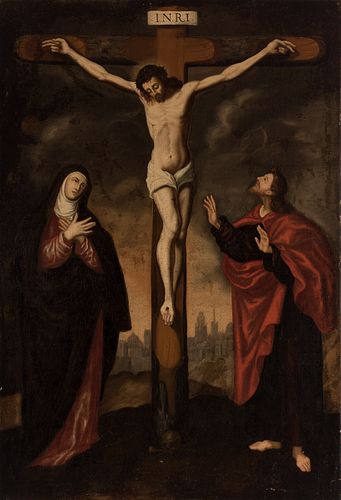Spanish school; XVII century. "Crucifixion". Oil on canvas. Relined.
Lot 67
About Seller
Setdart Auction House
Carrer Aragó 346
Barcelona
Spain
Setdart Subastas was born in 2004 and is currently the first online art auction in Spain with solidity, prestige and reliability guaranteed by our more than 60,000 users. Setdart has a young, dynamic and enterprising team ready to successfully manage the purchase and sale of art works through custom...Read more
Estimate:
EUR€1,500 - EUR€2,000
$1,578.95 - $2,105.26
Absentee vs Live bid
Two ways to bid:
- Leave a max absentee bid and the platform will bid on your behalf up to your maximum bid during the live auction.
- Bid live during the auction and your bids will be submitted real-time to the auctioneer.
Bid Increments
| Price | Bid Increment |
|---|---|
| EUR€0 | EUR€10 |
| EUR€200 | EUR€25 |
| EUR€500 | EUR€50 |
| EUR€1,000 | EUR€100 |
| EUR€3,000 | EUR€200 |
| EUR€5,000 | EUR€500 |
| EUR€10,000 | EUR€1,000 |
| EUR€20,000 | EUR€2,000 |
| EUR€50,000 | EUR€5,000 |
About Auction
By Setdart Auction House
Oct 20, 2021
Set Reminder
2021-10-20 07:30:00
2021-10-20 07:30:00
America/New_York
Bidsquare
Bidsquare : OLD MASTERS
https://www.bidsquare.com/auctions/setdart-auction-house/old-masters-7700
Setdart Auction House sofia@setdart.com
Setdart Auction House sofia@setdart.com
- Lot Description
Spanish school; XVII century. "Crucifixion". Oil on canvas. Relined. Presents repainting, restorations and missing in the frame. Size: 126 x 86 cm; 136 x 98 cm (frame). In this work the author captures a work full of great drama that shows the moment in which Christ is already dead on the cross, being accompanied by the Virgin Mary and St. John. It is an Iconographic evolved from the original Byzantine Déesis, which represented Christ in Majesty accompanied by Mary and St. John the Baptist. In Western art, the representation of Christ on the cross will be preferred, as a narrative scene, and the figure of St. John the Baptist will be replaced by that of John the Evangelist. However, as in the Byzantine Déesis, in the western model both the Virgin and St. John have their faces raised or oriented towards Christ, with their hands in a position of supplication on behalf of humanity. In this composition we also see, at the foot of the cross, the skull and Adam's tibia, a symbol that alludes to the figure of Christ as the new Adam, as redeemer of man's sin. The three figures are placed in the foreground, in front of a low stone wall behind which the landscape develops in depth, with the city of Jerusalem in the background, under a turbulent and ominous sky. In order to emphasize the drama of the composition, the author has played with the lighting and creates a much darker atmosphere in the foreground, while the background appears more illuminated, worked in tones of the same range, mainly earthy and reddish, tinged with bluish and green touches, but much lighter than those of the foreground. This marked effect in the illumination is a typical plastic resource of mannerism, which breaks with classical norms in its search for a more conceptual, symbolic and above all expressive art. Another clearly mannerist resource, which can be appreciated here at first sight, is the marked spatial tension derived from the large size of the figures of the Virgin and St. John, which occupy a large part of the pictorial surface. Their monumentality, enhanced by their ample vestments, contrasts with the thinness of Christ, in a way that emphasizes his defenselessness and physical suffering. Next to his mother and his disciple, Jesus appears small, his almost lifeless body broken and pale, which greatly accentuates the drama of the representation. Nevertheless, apart from these clearly mannerist elements we see features that remain faithful to classicism, especially in the chromatic aspect of the foreground. Further out, in the background landscape, we do see anti-classical colors, undefined and strangely bleached by the artificial light, but in the foreground the carmine and green of the cloaks of St. John and the Virgin dominate, large planes of color that are echoed in the space around them, and which appear magnificently toned and balanced. Nevertheless, we see a somewhat more dramatic work of light than was usual in the previous century, with lighter colors and more complex shades. Another feature that remains faithful to classicism is the composition, orderly and clearly pyramidal, determined by the heads of the three characters. It is a rational scheme, balanced and centered not only by its form, but also by the looks of the lateral characters, which converge in the face of Christ.
- Shipping Info
-
In-house shipping available. Please inquire at admin@setdart.com.
-
- Buyer's Premium



 EUR
EUR CAD
CAD AUD
AUD GBP
GBP MXN
MXN HKD
HKD CNY
CNY MYR
MYR SEK
SEK SGD
SGD CHF
CHF THB
THB









